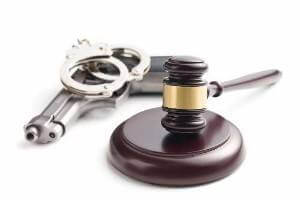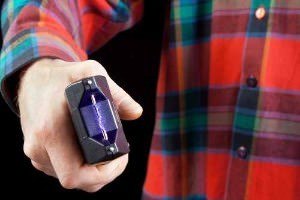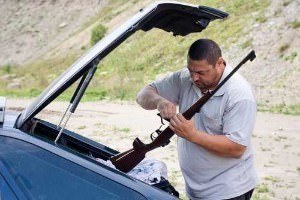New York State has some of the toughest gun and other weapon laws and restrictions in the nation. Possessing a gun without a permit, carrying a legal and registered gun in the wrong place, or even carrying a knife that’s “too large” could result in criminal charges; seemingly minor complications could turn misdemeanors into felony charges carrying mandatory minimum prison sentences, heavy fines, and other serious, irrevocable consequences.
Whether you’ve been charged with simple criminal possession of a weapon, or the involvement of a weapon has raised the stakes in a case of criminal menacing or assault, you need to act quickly to learn about the major distinctions between different weapons charges in the New York State Penal Code, and select an attorney who can help you navigate those toward the best possible outcome of your trial.
Criminal possession and use of a weapon
 While you don’t need a permit to purchase a rifle or shotgun in New York State (except in NYC), you do need a permit to purchase a pistol. In most New York State counties (especially those containing large cities, as is the case with Erie County and Buffalo), few applicants will get a pistol permit without “restrictions.” These specify the intended use of the pistol: target practice, hunting, or possession on “premises” (as in a home or business to protect that home or business). Citizens seeking an unrestricted pistol permit would have to offer “justifications.”
While you don’t need a permit to purchase a rifle or shotgun in New York State (except in NYC), you do need a permit to purchase a pistol. In most New York State counties (especially those containing large cities, as is the case with Erie County and Buffalo), few applicants will get a pistol permit without “restrictions.” These specify the intended use of the pistol: target practice, hunting, or possession on “premises” (as in a home or business to protect that home or business). Citizens seeking an unrestricted pistol permit would have to offer “justifications.”
Assault weapons are also banned under the NY SAFE Act, passed in 2013. Aside from mandating background checks for firearm and ammunition purchases (including private transactions) and allowing police officers to seize weapons based on probable cause (without a warrant), the SAFE Act also bans “assault weapons,” identified by certain features. The only exceptions are “antique” assault weapons, or those owned by current or former members of the police or military.
Depending on other circumstances, possession of a firearm in New York State might be “criminal” if:
- It is loaded.
- It is a handgun (and you do not have a permit).
- It is an assault weapon.
- It is unregistered.
In addition to restrictions on guns, certain weapons, including switchblades and brass knuckles, are illegal without qualification. And even the display of a firearm during the commission of another felony would itself be a class C or B felony.
If you’re facing any weapons charge, you should understand the parts of the New York State Penal Code pertaining to the possession, use, and sale of weapons. (The following is taken from that code, with slight modifications for ease of reading.)
Criminal possession of a weapon in the fourth degree – class A misdemeanor*
 A person is guilty of criminal possession of a weapon in the fourth degree when:
A person is guilty of criminal possession of a weapon in the fourth degree when:
- He or she possesses any firearm, electronic dart gun, electronic stun gun, gravity knife, switchblade knife, pilum ballistic knife, metal knuckle knife, cane sword, billy, blackjack, bludgeon, plastic knuckles, metal knuckles, chuka stick, sand bag, sand club, wrist-brace type slingshot or slingshot, shirken or “Kung Fu star”; or
- Possesses any dagger, dangerous knife, dirk, razor, stiletto, imitation pistol, or any other dangerous or deadly instrument or weapon with intent to use the same unlawfully against another; or
- Possesses a rifle, shotgun, antique firearm, black powder rifle, black powder shotgun, or any muzzle-loading firearm, and has been convicted of a felony or serious offense; or
- Possesses any dangerous or deadly weapon and is not a citizen of the United States; or
- Is a person who has been certified not suitable to possess a rifle or shotgun, and refuses to yield possession of such rifle or shotgun upon the demand of a police officer; or
- Knowingly possesses a bullet containing an explosive substance designed to detonate upon impact; or
- Possesses any armor piercing ammunition with intent to use the same unlawfully against another.
* Criminal possession of a weapon on school grounds is raised to a class E felony.
Criminal possession of a weapon in the third degree – class D felony
A person is guilty of criminal possession of a weapon in the third degree when:
- Such person commits the crime of criminal possession of a weapon in the fourth degree and has been previously convicted of any crime; or
- Such person possesses any explosive or incendiary bomb, bombshell, firearm silencer, machine-gun or any other firearm or weapon simulating a machine-gun and which is adaptable for such use; or
- Such person knowingly possesses a machine-gun, firearm, rifle or shotgun which has been defaced for the purpose of concealment or prevention of the detection of a crime or misrepresenting the identity of such machine-gun, firearm, rifle or shotgun; or
- Such person
- possesses three or more firearms; or
- possesses a firearm and has been previously convicted of a felony or a class A misdemeanor defined in this chapter within the five years immediately preceding the commission of the offense and such possession not take place in the person’s home or place of business; or
- Such person knowingly possesses any disguised gun; or
- Such person possesses an assault weapon; or
- Such person possesses a large capacity ammunition feeding device; or
- Such person possesses an unloaded firearm and also commits a drug felony as part of the same criminal transaction; or
- Such person possesses an unloaded firearm and also commits any violent felony offense as part of the same criminal transaction.
Criminal possession of a weapon in the second degree – class B felony
A person is guilty of criminal possession of a weapon in the second degree when:
- With intent to use the same unlawfully against another, such person:
- possesses a machine-gun; or
- possesses a loaded firearm; or
- possesses a disguised gun; or
- Such person possesses five or more firearms; or
- Such person possesses any loaded firearm. Such possession shall not constitute a violation of this subdivision if such possession takes place in such person’s home or place of business.
Criminal possession of a dangerous weapon in the first degree – class B felony
A person is guilty of criminal possession of a weapon in the first degree when such person:
- Possesses any explosive substance with intent to use the same unlawfully against the person or property of another; or
- Possesses ten or more firearms.
Criminal use of a firearm in the second degree – class C felony
A person is guilty of criminal use of a firearm in the second degree when he [or she] commits any class C violent felony offense and either:
- Possesses a deadly weapon, if the weapon is a loaded weapon from which a shot, readily capable of producing death or other serious injury may be discharged; or
- Displays what appears to be a pistol, revolver, rifle, shotgun, machine gun or other firearm.
Criminal use of a firearm in the first degree – class B felony
A person is guilty of criminal use of a firearm in the first degree when he [or she] commits any class B violent felony offense and either:
- Possesses a deadly weapon, if the weapon is a loaded weapon from which a shot, readily capable of producing death or other serious injury may be discharged; or
- Displays what appears to be a pistol, revolver, rifle, shotgun, machine gun or other firearm.
Criminal sale of a firearm
 A person is guilty of criminal sale of a firearm in the third degree* when such person is not authorized pursuant to law to possess a firearm and such person unlawfully either:
A person is guilty of criminal sale of a firearm in the third degree* when such person is not authorized pursuant to law to possess a firearm and such person unlawfully either:
- Sells, exchanges, gives or disposes of a firearm or large capacity ammunition feeding device to another person; or
- Possesses a firearm with the intent to sell it.
* Selling or possessing with intent to sell five or more firearms (second degree) is a class C felony. Selling or possessing with intent to sell 10 or more firearms (first degree) is a class B felony.
Criminal menacing
A weapon could also complicate a criminal menacing charge. Under the New York State Penal Code, a person is guilty of menacing in the third degree when,
by physical menace, he or she intentionally places or attempts to place another person in fear of death, imminent serious physical injury, or physical injury.
This is a class B misdemeanor, punishable by up to 90 days in jail.
While a weapon isn’t necessary to qualify an interaction as an act of “menacing,” it’s hard to deny that fear is a reasonable reaction to the display of a weapon. The presence or use of a weapon could raise a charge of criminal menacing from class B to class A.
A person is guilty of menacing in the second degree, a class A misdemeanor, when:
- He or she intentionally places or attempts to place another person in reasonable fear of physical injury, serious physical injury or death by displaying a deadly weapon, dangerous instrument, or what appears to be a pistol, revolver, rifle, shotgun, machine gun, or other firearm; or
- He or she repeatedly follows a person or engages in a course of conduct or repeatedly commits acts over a period of time intentionally placing or attempting to place another person in reasonable fear of physical injury, serious physical injury, or death; or
- He or she commits the crime of menacing in the third degree in violation of that part of a duly served order of protection, or such order which the defendant has actual knowledge of because he or she was present in court when such order was issued, pursuant to article eight of the family court act, section 530.12 of the criminal procedure law, or an order of protection issued by a court of competent jurisdiction in another state, territorial or tribal jurisdiction, which directed the respondent or defendant to stay away from the person or persons on whose behalf the order was issued.
A charge of menacing in the second degree is automatically raised to menacing in the first degree, a class E felony, if the person has been previously convicted of menacing in the second degree, or of menacing a police officer or other peace officer within the preceding ten years.
Assault
 All forms of assault are serious offenses, but the level of the charge depends on three factors: the extent of the injuries, the intent of the negligent or violent party, and the use of a any weapons. A prior felony conviction may increase the length of a prison sentence. If the assault was on a police office, judge, or child under the age of 11, this will also increase the length of the prison sentence and the fine.
All forms of assault are serious offenses, but the level of the charge depends on three factors: the extent of the injuries, the intent of the negligent or violent party, and the use of a any weapons. A prior felony conviction may increase the length of a prison sentence. If the assault was on a police office, judge, or child under the age of 11, this will also increase the length of the prison sentence and the fine.
According to the New York State Penal Code, a person is guilty of assault in the third degree (a class A misdemeanor) when:
- With intent to cause physical injury to another person, he or she causes such injury to such person or to a third person; or
- He or she recklessly causes physical injury to another person; or
- With criminal negligence, he or she causes physical injury to another person by means of a deadly weapon or a dangerous instrument.
The New York Penal Code’s section on second degree assault is long and dense. For the purposes of this post, a person is guilty of assault in the second degree (a class D felony) when:
- With intent to cause serious physical injury to another person, he or she causes such injury to such person or to a third person; or
- With intent to cause physical injury to another person, causes such injury to such person or to a third person by means of a deadly weapon or a dangerous instrument; or
- Intentionally prevents a public servant from performing his or her occupational duties; or
- Recklessly causes serious physical injury to another person by means of a deadly weapon or a dangerous instrument; or
- He recklessly causes physical injury to another person who is a child under the age of eighteen by intentional discharge of a firearm, rifle or shotgun; or
- Intentionally administers a drug to a person to cause stupor; or
- Causes physical injury to anyone while committing another felony; or
- Having been charged with or convicted of a crime and while confined in a correctional facility, as defined in subdivision three of section forty of the correction law, pursuant to such charge or conviction, with intent to cause physical injury to another person, he causes such injury to such person or to a third person; or
- Recklessly causes serious physical injury to a person under 11; or
- Intentionally causes serious injury to a person at least 65 years old, if the actor is at least 10 years younger.
Assault in the second degree is punishable by up to 7 years in a state prison.
Assault in the first degree is a class B violent felony. First degree assault carries a mandatory minimum five-year prison sentence, with a maximum of 30 years. A person is guilty of assault in the first degree when,
- With intent to cause serious physical injury to another person, he causes such injury to such person or to a third person by means of a deadly weapon or a dangerous instrument; or
- With intent to disfigure another person seriously and permanently, or to destroy, amputate or disable permanently a member or organ of his body, he causes such injury to such person or to a third person; or
- Under circumstances evincing a depraved indifference to human life, he recklessly engages in conduct which creates a grave risk of death to another person, and thereby causes serious physical injury to another person; or
- In the course of and in furtherance of the commission or attempted commission of a felony or of immediate flight therefrom, he, or another participant if there be any, causes serious physical injury to a person other than one of the participants.
If you’ve injured someone with a weapon, you’ll need a skilled criminal defense attorney to present your case to the judge. Your defense in a case of injury involving a weapon will hinge on the other factors that determine the degree of an assault charge: your intent, and the extent of the injury. If the injury was not serious, you may have the charge reduced from first degree assault. Your attorney may also argue that the “assault” was unintentional (essentially an accident) or that it was an act of self-defense or the defense of another.
Retrieving your property from the police
 If you’ve been charged with a crime involving the use or possession of a weapon, the police may have seized that weapon. If the weapon is illegal in New York State – for example, if it is an assault rifle or a switchblade – you will not be able to retrieve that weapon. However, if the weapon is not contraband – if it is a handgun for which you have a permit, or if it is a knife of an acceptable size – then the police may not deprive you of your right to that property.
If you’ve been charged with a crime involving the use or possession of a weapon, the police may have seized that weapon. If the weapon is illegal in New York State – for example, if it is an assault rifle or a switchblade – you will not be able to retrieve that weapon. However, if the weapon is not contraband – if it is a handgun for which you have a permit, or if it is a knife of an acceptable size – then the police may not deprive you of your right to that property.
When you can retrieve your property will depend on whether the item is “evidence.” If the item is evidence in your case or another case in which you are involved, you will not be able to retrieve it until the case is concluded in court. If the item is not evidence, you can retrieve it after your arraignment.
Your Ticket to Justice
Weapons laws are complicated and, especially in cases of assault and menacing, the outcome of a trial depends a great deal on provable intent and other nuances. In over 30 years as a public defender and a privately practicing criminal defense attorney in Buffalo NY, Arthur Pressman has handled over 40,000 cases, most of them in Western New York. There’s no time to waste: contact Arthur Pressman’s offices today to set up a free and confidential consultation.
In the meantime, you can learn more about criminal charges and defenses by perusing our blog or informational videos. You can also find more information on weapons charges and defenses in our New York Assault Penalty Guide.
